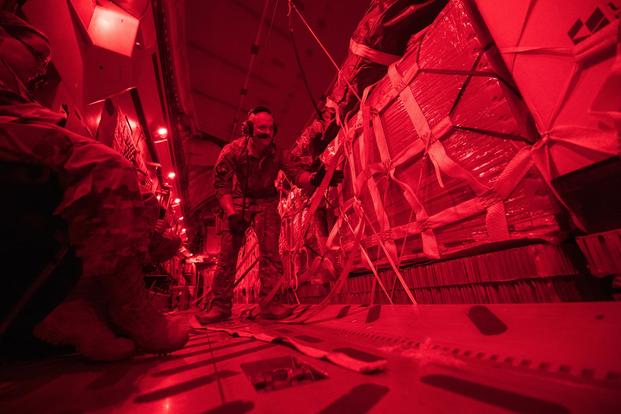The U.S. Air Force is using the C-17 Globemaster III for combat-airdrop operations in Afghanistan for the first time in nearly a year and a half, according to the 379th Air Expeditionary Wing.
The cargo airlifter, based out of Al Udeid Air Base, Qatar, made a drop over Southern Afghanistan on May 10, a release from the wing states.
Without giving specifics, the Air Force delivered roughly a dozen pallets of general cargo over an austere location in Afghanistan for Operation Freedom's Sentinel, the release added.
"Our tasking and the aircraft selection for this mission really comes down to the C-17's larger cargo capacity," said Maj. Nicholas Coblio, mission aircraft commander from the 816th Expeditionary Airlift Squadron, in the release. "The C-17 can complete this mission with one aircraft in one pass, minimizing risk and maximizing productivity."
Related content:
- Flying with the 'Blue Collar Guys' on a C-130 Mission in Iraq
- Dignified Transfer: A Quiet Mission for Airlift in the Middle East
- General Warns of Need to Boost Airlift Capacity
The crew, which included members of the 816th Expeditionary Airlift Squadron, picked up the cargo at Bagram Airfield, where U.S. soldiers from the Al Udeid-based 824th Quartermaster Detachment assembled the pallets, completing the final rigging for the drop.
Airdrops often use GPS to guide the package to crews on the ground, improving accuracy. The Air Force in 2007 began using the Joint Precision Airdrop System (JPADS), allowing airdrops to be conducted from higher altitudes.
"This airdrop represents a very significant mission -- delivering needed supplies while reducing the burden and risk on our Army helicopter and maintenance crews," said Army Chief Warrant Officer 2 David Beville, with the 3rd Infantry Division's Resolute Support Sustainment Brigade.
"This is our sole job. Regardless of what we are dropping, our job is to throw stuff out of planes to people that need it," Beville said, adding that loadmasters worked for 30 hours to prepare, assemble and rig the cargo.
According to the Defense Department, the Al Udeid-based C-17s in January began moving cargo throughout Afghanistan for the first time since 2016. That year, the 816th squadron flew more than 2,400 missions, moving nearly 102,000 tons of cargo and almost 120,000 passengers, including 116 aeromedical patients.
The C-17 is set to reach the end of its service life in the early 2030s, officials have said. The Air Force has 213 Globemasters, made by Boeing Co., according to official inventory data.
The service is making use of all its cargo transport aircraft, including the C-5 Super Galaxy and C-130 Hercules, by rotating its fleet through the total force to extend aircraft longevity.
Air Mobility Command has been rotating its C-17 fleet between the active duty, Reserve and Guard to stretch its lifespan -- or enterprise fleet management, as AMC calls it.
By rotating the Globemasters among the three components, Air Mobility Command believes "we'll gain 10 to 20 years for service life on the C-17," Capt. Theresa Izell, a maintenance officer, said during a media day at Andrews Air Force Base, Maryland.
"This isn't really revolutionary," Izell said last year, adding it's a way of sharing resources in the near term throughout the components.
For missions in the Middle East, airlift crews will move on average 10 to 20 tons of cargo on a daily basis, in addition to transporting special operations forces, allies and civilians.
"It's a complex environment," said Col. Charles D. Bolton, 386th Air Expeditionary Wing commander, told Military.com last year. "We fly with the same defense systems we've had for a while. We're trained to operate in this environment and have been for many, many years."
-- Oriana Pawlyk can be reached at oriana.pawlyk@military.com. Follow her on Twitter at @Oriana0214.










